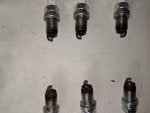Hi All,
Driving home today and the 06' Ridgeline (83K miles) died on the way down a mountain pass. I was able to put it into neutral and restart it, but then I noticed on acceleration it seemed to not be running properly. At the off ramp it died and would not start again. My first thought was fuel pump, or relay. However, when I checked I could audibly hear the fuel pump activating with the key in the on position. After a tow home I also checked and confirmed that fuel was flowing under the hood before the fuel rail.
A couple of things...
I have only had the truck for a few weeks, but it ran fine previously to this. No rough idle (I saw the EGR valve could cause cranking but no start issues).
I have a spark plug tester on order from Amazon and should arrive tomorrow. However, I was wondering if I could just take out the plug, hook it up to the coil and ground it against the engine and see a spark? I've done with with small carborated engines in the past.
The truck only came with the vallet key, I see some post about this causing issues, however, I've been driving the truck around for a few weeks with no issues.
UPDATE: I went out again to try to start the truck, and was able to get it started. If I kept the rpm's up it would run and it would idle if I let it down slowly, however if I revved the engine and then let off the gas, it would die.
I also hooked up my bluetooth OBDII reader and see the code P0139 listed as pending.
Here is a short video showing my issue.
https://youtu.be/FUnJ_l3I6Ys
Any ideas?
Thanks
Driving home today and the 06' Ridgeline (83K miles) died on the way down a mountain pass. I was able to put it into neutral and restart it, but then I noticed on acceleration it seemed to not be running properly. At the off ramp it died and would not start again. My first thought was fuel pump, or relay. However, when I checked I could audibly hear the fuel pump activating with the key in the on position. After a tow home I also checked and confirmed that fuel was flowing under the hood before the fuel rail.
A couple of things...
I have only had the truck for a few weeks, but it ran fine previously to this. No rough idle (I saw the EGR valve could cause cranking but no start issues).
I have a spark plug tester on order from Amazon and should arrive tomorrow. However, I was wondering if I could just take out the plug, hook it up to the coil and ground it against the engine and see a spark? I've done with with small carborated engines in the past.
The truck only came with the vallet key, I see some post about this causing issues, however, I've been driving the truck around for a few weeks with no issues.
UPDATE: I went out again to try to start the truck, and was able to get it started. If I kept the rpm's up it would run and it would idle if I let it down slowly, however if I revved the engine and then let off the gas, it would die.
I also hooked up my bluetooth OBDII reader and see the code P0139 listed as pending.
Here is a short video showing my issue.
https://youtu.be/FUnJ_l3I6Ys
Any ideas?
Thanks






